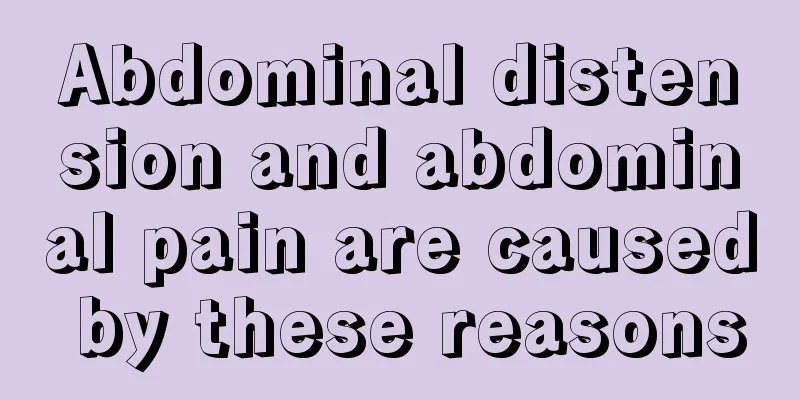Abdominal distension and abdominal pain are caused by these reasons

|
Abdominal distension and abdominal pain are common diseases nowadays. Abdominal distension and abdominal pain will not only cause stomach pain, but also affect multiple organs of the body. Patients with abdominal distension and abdominal pain should understand the specific factors in their daily lives. They may consider poor diet, eating raw and cold food, excessive dieting, and irregular meals to cause abdominal distension and abdominal pain. In addition, pathological factors cannot be ruled out, so the cause should be clarified in time and the appropriate method should be chosen for treatment and diagnosis. Pathological etiology 1. Causes of acute abdominal pain (1) Diseases of abdominal organs: ① Acute inflammation of abdominal organs: acute gastroenteritis, acute corrosive gastritis, acute cholecystitis, acute pancreatitis, acute appendicitis, acute cholangitis, etc. ② Perforation or rupture of abdominal organs: perforation of gastric and duodenal ulcers, perforation of typhoid intestinal organs, rupture of liver, rupture of spleen, rupture of kidney, rupture of ectopic pregnancy, rupture of ovary, etc. ③ Obstruction or expansion of abdominal organs: gastric mucosal prolapse, acute intestinal obstruction, inguinal hernia, intussusception, biliary ascariasis, cholelithiasis, kidney and ureteral stones, etc. ④ Torsion of abdominal organs: acute gastric torsion, ovarian cyst torsion, omentum torsion, intestinal torsion, etc. ⑤ Intra-abdominal vascular obstruction: acute obstruction of the mesenteric artery, acute portal vein thrombosis, dissecting abdominal aortic aneurysm, etc. (2) Abdominal wall diseases: abdominal wall contusion, abdominal wall abscess and abdominal wall herpes zoster, etc. (3) Chest diseases: acute myocardial infarction, acute pericarditis, angina pectoris, pneumonia and pulmonary infarction, etc. (4) Systemic diseases and others: rheumatic fever, uremia, acute lead poisoning, porphyria, abdominal allergic purpura, abdominal epilepsy, etc. 2. Causes of chronic abdominal pain (1) Diseases of abdominal organs: ① Chronic inflammation: reflux esophagitis, chronic gastritis, chronic cholecystitis, chronic pancreatitis, tuberculous peritonitis, inflammatory bowel disease, etc. ② Gastric, duodenal ulcer and gastrinoma, etc. ③Torsion or obstruction of abdominal organs: chronic gastrointestinal torsion, intestinal adhesions, omental adhesion syndrome, etc. ④ Increased organ capsule tension: liver congestion, hepatitis, liver abscess, liver cancer, splenomegaly, etc. ⑤ Gastrointestinal motility disorders: gastroparesis, functional dyspepsia, hepatic flexure and splenic flexure syndrome. |
<<: What to eat to cleanse the intestines and promote bowel movements
>>: What methods can be used to regulate insufficient gastric motility?
Recommend
Daily dietary principles for teratoma patients
Teratoma is a type of benign ovarian tumor that c...
What is the TCM treatment method for small cell lung cancer
Small cell lung cancer is a type of bronchial can...
What methods can cure fibroids
What methods can cure fibroids? With the increasi...
A brief analysis of the prevention of osteosarcoma
I think everyone will feel a shiver in their hear...
Is it necessary to take medicine if the thyroid cancer is not completely removed
Incomplete removal of thyroid cancer may require ...
What are the dangers of long-term loose stools
The harm of long-term loose stools is indeed quit...
Dermatology laser treatment
Laser is a medical method widely used in the fiel...
What are the treatments for nodular acne
In daily life, our skin often has some problems, ...
What are the differences between rice and brown rice
Maybe many of us use some rice in our daily life....
Physical methods of cooling down a fever
Fever is something that almost everyone has exper...
What is beauty and what kind of beauty is suitable for you?
The word "beauty" is very popular nowad...
What is the best way to repair hair damage
Modern people pursue individuality, and they ofte...
Is it OK for children to eat soy sauce?
When we cook, we often add various seasonings acc...
Pain in liver area
The liver is the most important organ in the huma...
Is it expensive to treat small cell lung cancer?
Is the cost of treating small cell lung cancer hi...









